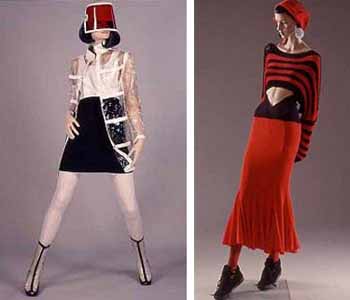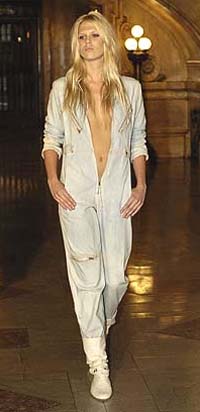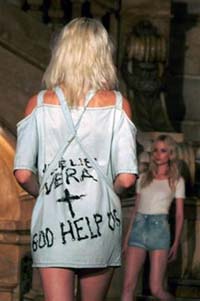 |
Manners, Customs, Clothing
The Imitation of Christ Collection:
A Subversive Message in Fashion
Marian T. Horvat, Ph.D.
When I was a girl, the closest I got to the haut couture of the fashion capitals of the world was to thumb through the Vogue magazines at my Aunt Pat’s house in St. Mary’s, KS. I am almost sure she had the only subscription to Vogue in that small German Midwestern town, notably Catholic and conservative before the Cultural Revolution imposed its vulgar and egalitarian habits indiscriminately on U.S. society.
What I saw in those fashion magazines absolutely astounded me. Did women really wear such eccentric outfits? The Parisian fashion dictators were promoting the miniskirt in the 1960s. I would wonder: Who would wear such a ridiculous outfit such as the one at left, with its plastic PVC coat and visored helmet? A decade later, the immodest cut-outs were making their appearance, giving an immoral and extravagant hue to even a normal knit dress, below.

Left, the 1960s heralded the miniskirt and plastic coats and visors; right, a 1980s outfit features a cut-out midriff and inappropriate shoes |
By extravagant, I mean exaggerated, showy, and outside what is reasonable. The Church taught that mode (style) and modesty should go hand in hand like sisters, since both words derive from the Latin modus, meaning a right measure, without deviations in one direction or the other - either superfluous vanity or vulgar tackiness.
Today’s exaggerations in fashion make those once-astounding styles look tame indeed. On one end we see the extravagant chic of Hollywood stars and the Chanel, Valentino, Yves St. Laurent, et alii lines, where fashion has followed the conduit from the eccentric to the scandalous. Designers vie to expose women’s stomachs, breasts and other parts in the most bizarre and immoral modes possible. The gowns of Hollywood stars made by these couturiers worn on Oscar nights, for example, are often blatantly scandalous. For many, this is what is understood as glamorous and chic.
On the other end of the designer world spectrum, we can find the summit of vulgarity and tackiness, if, in fact, ugliness can have a high point. Better said, let me present one of the nec plus ultra of vulgarity – the Spring 2006 collection that appears under the shocking name of Imitation of Christ, IOC for short.
The IOC label was launched in Fall 2000 by art-school dropout and aspiring actress Tara Lyn Subkoff and friend Matthew Damhave, who consider themselves “social engineers.” What their line proclaims is the triumph of minimalism: less is better - less elegance, less beauty, less taste. Adding insult to injury is the package’s blasphemous title.
Imitation of Christ – its origin
The real origin of the title Imitation of Christ, as Catholics know, is the pious book of mediations by Thomas a Kempis who died in 1471. It teaches us to live following the steps of Our Divine Redemptor.

The 2006 IOC line presented models with bound hands; others, at right, wear patched or stained clothing - N.Ymag.com |
The Imitation of Christ fashion line, to the contrary, is the epitome of “hip” and tastelessness. Its designer knows full well what she is doing – she comes from a Catholic family. Questioned about the name, she laughs and refuses to comment, other than the quip that she considers Christ “a real rebel,” like herself.
What she boastfully makes is subversive fashion. Her original idea was to never make clothing with new material, but just take rejects and cast-offs and reconstruct them. It is a bizarre example of recycling: take a thrift store bargain, add patchwork and some new slashes, and tack on a $500 or $1,000 price tag. To complete the revolt against the establishment, Subkoff gives ludicrous fashion tips such as to wear thick tube socks with one of her $1,200 party dresses.
IOC matches its vagabond chic with a rebellious presentation. The first year, the IOC showing was in a Manhattan Jewish funeral parlor. In 2001, the models were seated in the front row and the fashion buyers/reviewers were made to walk the runway. Another year featured topless housewives pushing vacuum sweepers in a furniture showroom. In the 2006 show, as you can see, many of the models walked the plank with their hands bound behind their backs. Is it to imply that they are prisoners of the establishment?
Vulgar and blasphemous
What is certain is that this 2006 Spring collection celebrates what is ugly, immoral and vulgar.

Above, a faded provocative jumpsuit from the IOC line; below, a cut-out t-shirt with words and a cross placed on the model's derriere
 |
First, the IOC models try to be as shabby and defiant as possible.
Second, the models wear dingy, grungy clothing. How low has the culture sunk to present a line of clothing that looks like it came off the backs of beggars?
Is this high fashion? It is sad to see the vulgar clothes that everyone is already wearing presented as the latest expression of fashion. There is nothing original about it. You can see youth dressed like this milling around at almost any high school or college.
Third, the only new thing about these cast-offs is that they masquerade as high fashion. Also, a blasphemous hue is added by the attachment of the name Imitation of Christ to them.
Fourth, the principal message these seditious “social engineers” send is this: There should be no more dignity, elegance, or glamour of dress. Everyone, regardless of position or place, should wear the same denim skirt or jeans, the same cotton t-shirt and tennis shoes. Communist doctrine considers all inequalities – including those of dress – unjust and harmful. It is difficult to deny that the IOC collection contributes to this Communist goal to level everything. This seems to be the aim of their purported "social engineering."
On the contrary, traditional Catholic doctrine proclaims the legitimacy and even necessity of just and proportional inequalities among men. Further, such inequalities should be represented by visible signs - such as clothing, which should be a dignified expression of the sex, age, and social position of a person.
St. Thomas Aquinas says that dressing well is a meritorious act of virtue when it conforms to the state, position, and dignity of the person (Summa Theologiae, 2a-2ae, q. 169, art. 1).
Pope Pius XII repeated this norm to an International Congress of Master Tailors in 1954, stating that clothing, and especially formal clothes, should aim at making visible through the richness of their materials and their irreproachable tailoring the excellence of the one who wears them.
These principles were applied in Christendom throughout the glorious Age of Faith. The Catholic knight, and its later heir, the Catholic gentleman, cultivated excellence, beauty and refinement in manners and dress because he took for a model the ideal of knight and gentleman, Our Lord Jesus Christ, who is excellence and refinement par excellence. Taking Christ as a archetype, the Catholic gentleman became a model for men of all classes, whose customs and ways of being simultaneously tended to raise all of society toward perfection. The foundation and model for a Catholic culture is Our Lord Jesus Christ.
The Imitation of Christ line implicitly preaches the exact opposite. It is a rejection of the beauty, excellence, and perfection of Christian Civilization. These faded denim “fashions”, egalitarian and utilitarian in nature, are stripped of dignity, beauty, and refinement. Apparently the line represents a supposedly revolutionary Christ who would reject the characteristics of Christian Civilization. It is diametrically opposed to the dignified dress of our Catholic past and to the true image of Christ.
It does not seem superfluous to add that this imaginary Communist model of Christ is well received by many sectors of the Progressivist Church, which proclaims the doctrine of bare-boned poverty in its stripped and impoverished liturgy, altars, and vestments.
In summary, the IOC collection unites bad taste, extravagance, immodesty, and a Communist way of dressing. But the most rejectable part of the collection – and the principle reason I am commenting on it – is its blasphemous name.

Posted November 21, 2005

Related Topics of Interest
 Questions and Answers on Fashion in Women's Clothing Questions and Answers on Fashion in Women's Clothing
 Good Customs Fit with Good Principles Good Customs Fit with Good Principles
 Styles Reflect the Moral Profiles of Peoples and Epochs Styles Reflect the Moral Profiles of Peoples and Epochs
 Language Is the Dress of Thought Language Is the Dress of Thought
 Is Being Frank Always Advisable? Is Being Frank Always Advisable?
 Courtesy in the Catholic Home Courtesy in the Catholic Home

Related Works of Interest
|
|
Manners | Cultural | Home | Books | CDs | Search | Contact Us | Donate

© 2002- Tradition in Action, Inc. All Rights Reserved
|
 |
|